Category Archives: APS March Meeting 2016
Getting a fix on quantum computations

Bit of choice: A photograph of the nine superconducting qubit device developed by the Martinis group at the University of California, Santa Barbara, where, for the first time, the qubits are able to detect and effectively protect each other from bit errors. (Courtesy: Julian Kelly/Martinis group)
By Tushna Commissariat in New York City, US
Although the APS March meeting finished last Friday and I am now in New York visiting a few more labs and physicists in the city (more on that later), I am still playing catch-up, thanks to the vast number of interesting talks at the conference. One of the most interesting sessions of last week, and a pretty popular one at that, was based on “20 years of quantum error correction” and I went along to the opening talk by physicist John Preskill of the California Institute of Technology. I had the chance to catch up with Preskill after his talk and we discussed just why he thinks that we are not too far away from a true quantum revolution.
Just in case you haven’t come across the subject already, quantum error correction is the science of protecting quantum information (or qubits) from errors that would occur as the information is influenced by the environment and other sorts of quantum noise, causing it to “decohere” and lose its quantum state. Although it may seem premature that scientists have been working on this problem for nearly two decades when an actual quantum computer has yet to be built, we know that we must account for such errors if our quantum computers are ever to succeed. It will be essential if we want to achieve fault-tolerant quantum computation that can deal with all sorts of noise within the system, as well as faults in the hardware (such as a faulty gate) or even a measurement.
Over the past 20 years, theoretical work in the field has made scientists confident that quantum computing of the future will be scalable. Preskill says that “it’s exciting because the experimentalists are taking it quite seriously now”, while initially the interest was mainly theoretical. Previously, scientists would artificially create the noise in the quantum systems that they would correct but now actual quantum computations can be fixed. Indeed, Preskill says that one of the key things that has really moved quantum error correction along in the past few years is the concentrated improvement of the hardware used, i.e. better gates with multiple qubits being processed simultaneously.
The firm that’s made no noise over gravitational waves
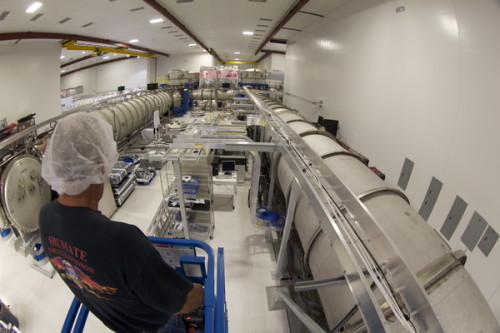
Power me up: Kepco’s kit was used to convert mains AC into DC for the lasers, electronics and other instrumentation at LIGO. (Courtesy: Caltech/MIT/LIGO Lab)
By Matin Durrani in Baltimore, Maryland, US
The exhibition hall at this year’s APS March meeting is so big that it can be hard to know who or what to see among the many companies displaying their wares or services. Fortunately, my colleague Joe Breck from IOP Publishing’s office in Philadelphia tipped me off about a great little story featuring Kepco Power Supplies, which is based in Flushing, New York.
I spoke to Mark Kupferberg, executive vice-president for power solutions at the firm, which was founded by his father and his two brothers in 1946 shortly afer the three had finished work on the Manhattan atomic-bomb project. Kepco mainly makes power supplies that convert mains AC into DC electricity, and has recently played a small but vital role in the discovery of gravitational waves, which were first predicted by Einstein 100 years ago.
APS launches LGBT Climate in Physics report
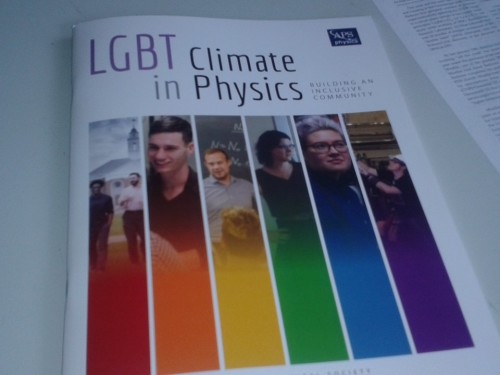
Lifting the lid: the LGBT Climate in Physics report launched at the APS March meeting.
By Matin Durrani in Baltimore, Maryland, US
I’ve been thinking a lot recently about the make-up of the physics community, particularly as this month saw Physics World publish a special issue, “Physics for all: building a more inclusive discipline”, that examined ways to make physics as welcoming as possible for everyone. It looked, for example, at “microaggressions” in physics, the role of unconscious bias and whether physics is just for people from better socioeconomic backgrounds.
One article that attracted particular attention – based on informal feedback and e-mails I’ve received since the issue came out – was “Where people and particles collide”. Written by my Physics World colleague Louise Mayor, it looks at what life’s like for gender and sexual minorities at the CERN particle-physics lab in Geneva and the challenges people there faced in setting up an official LGBT Cern Club. (There is still no such club, but CERN has set up an LGBT “informal network”.)
The issues facing gender and sexual minorities have also been a theme here at the APS March meeting, with the launch this morning of a new APS report LGBT Climate in Physics. The report is based on focus groups, a “climate survey” of more than 320 members of the US LGBT physics community, and follow-up interviews with five survey participants. A further 2596 members of the entire APS community replied to a separate survey, of whom 2.5% identified themselves as LGBT.
View all posts by this author | View this author's profile
Steven Weinberg defends his ‘Whig’ view of history
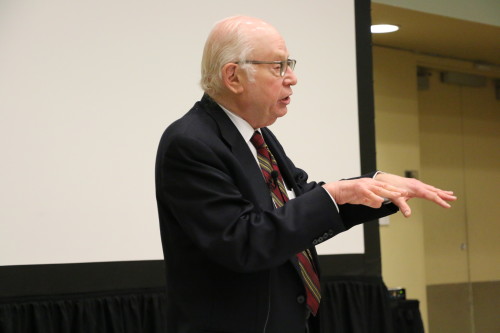
Steven Weinberg in full flow discussing his view of the history of physics.
By Matin Durrani in Baltimore, Maryland, US
I wasn’t planning on blogging about the talk that the Nobel-prize-winning physicist Steven Weinberg gave yesterday afternoon here at the APS March meeting. He’d been speaking about his recent book To Explain the World: the Discovery of Modern Science, which examines the history of physics from the ancient Greeks to the present day.
The book ruffled a fair few feathers when it was published last year, with historians and philosophers annoyed at Weinberg’s approach to history, which basically involves judging the past from the standpoint of the present. It’s known as the “Whig interpretation” of history and sees past events as a march towards enlightenment, ignoring dead-ends and blind alleys. It’s the history of winners, if you like.
I have probably mis-stated the criticisms of Weinberg book – I’m no historian – and that’s my point. I felt the arguments against his approach were too subtle and nuanced to fit in a blog. But I changed my mind this morning about covering the session Weinberg appeared in. Not only because the room where Weinberg gave his talk was full to bursting, with about 500 people present, but also because some of the things he said, which I Tweeted yesterday, were proving popular on Twitter. Clearly, people want to hear what Weinberg says – he’s a master of the soundbite – so here, for posterity, are a few of his thoughts.
The everyday physics of knitting, ribbon-curling and more
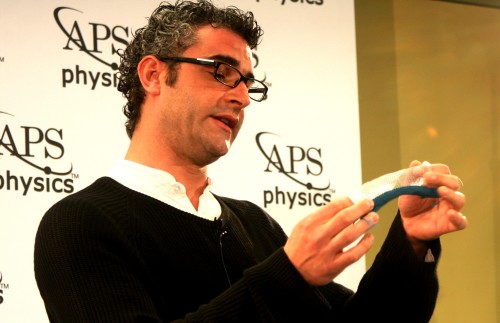
Knit stitch: Frédéric Lechenault talks about the physics of knitted materials. (Courtesy: James Riordon/APS)
By Tushna Commissariat in Baltimore, Maryland, US
You may think that a simple occurrence such as a tree shedding its leaves or an everyday activity such as knitting or ribbon-curling does not involve a great deal of physics, but you would be wrong. In a press session here at the APS March meeting entitled “The physics of everyday life”, three different groups of researches talked about the unexpectedly complex physical principles that govern all of the above mentioned instances.
Sunny Jung of the Bio-Inspired Fluid Lab at Virginia Tech in the US studies the shapes of different leaves and the thickness of their “petioles” or stalks – both of which determine the stresses a leaf can withstand on a windy day and what happens when it ultimately falls. Jung’s team studies this because leaves are actually very good at withstanding all kinds of stress and strain without buckling – something that could be applied to large man-made industrial objects such as suspended road-signs.
The researchers found that slender leaves are more likely to bend under high winds, whereas a flat leaf is more likely to twist at the stem before falling. They also discovered that the length of the stalk is determined by the size of the leaf, with larger leaves needing longer stems so that sunlight can cover more of their surface area.
Cutting the fat from chocolate
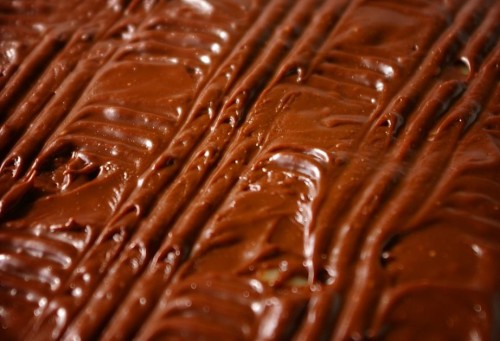
Go with the flow: physicist Rogjia Tao has a clever way to cut the fat in chocolate. (CC BY-SA 2.0/rore)
By Matin Durrani in Baltimore, Maryland, US
A couple of years ago my colleague James Dacey decided to give up eating chocolate, crisps, biscuits and cakes over Lent and it’s a virtuous – if very dull – decision I’ve been following every year since (even if James has long since strayed from the path of righteousness).
It was therefore with a dollop of smug satisfaction that I attended a talk at this year’s APS March meeting by Rongjia Tao – a physicist from Temple University in the US. He has developed a way of cutting the amount of fat in chocolate without, apparently, losing any of the taste.
Now, reducing the fat content in chocolate might seem straightforward – you just get rid of the fat, right? But it’s a harder problem than you’d think for chocolate manufacturers, who have to send liquid chocolate – a suspension of spherical cocoa particles in a melted fat of cocoa butter and other oils – down pipes and tubes.
Would you encourage your grandchildren into condensed-matter physics?
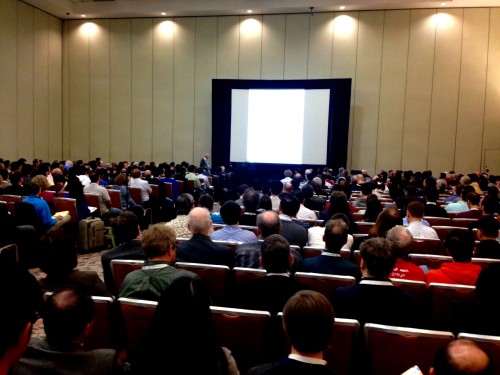
Packed in: a full room for Anthony Leggett’s talk. (Courtesy: Tushna Commissariat)
By Tushna Commissariat in Baltimore, Maryland, US
One of the most popular talks this morning at the APS March meeting was almost certainly given by Nobel-prize-winning physicist Anthony Leggett of the University of Illinois at Urbana-Champaign in the US. Leggett, who shared the 2003 Nobel Prize for Physics for his work on superconductors and superfluids, talked about his “Reflections on the past present and future of of condensed-matter physics”.
As the abstract of his talk suggests, Leggett looked at the ways, means and even the very definition of “condensed-matter physics” has changed and “evolved since its inception in the early 20th century, with particular reference to its relationship to neighbouring and even distant disciplines”. He went on to “speculate on some possible directions in which the discipline may develop over the next few decades, emphasizing that there are still some very basic questions to which we currently have no satisfactory answers”.
I missed the beginning of his talk as I was attending the morning’s first set of press briefings (more on those later) but when I did walk into the packed hall for his talk, his slide had the rather interesting title: “Would I encourage my grandchildren to go into condensed-matter physics?” Happlily enough, his answer at the end of his talk was a resounding “yes”.
Baltimore braces itself for physics

March madness: the APS March meeting at the Baltimore Convention Center (top) and the IOP Publishing stand at the exhibition. (Courtesy: Tushna Commissariat)
By Matin Durrani and Tushna Commissariat in Baltimore, Maryland, US
So here we are in Baltimore to attend the 2016 March meeting of the American Physical Society (APS). We’re writing this at the window seats in a burrito bar on Pratt Street while staring at the hulk that is the Baltimore Convention Center, where nigh-on 10,000 physicists will be congregating all week.
We’ve been playing a game of “spot the APS attendee” while tucking into our burritos. Without wishing to stereotype physicists (okay, go on then, we will) they’re the ones with the backpacks stuffed with poster tubes, pulling little trolley suitcases, looking lost before veering towards the convention centre.
There are also some physicists inside Chipotle Mexican Grill – you can tell because they’re huddled around laptops looking at PowerPoint presentations showing graphs of Fermi surfaces and topological insultators. Probably not the usual subject of discussion in here.
